Robust Dual Spatial Weighted Sparse Unmixing for Remotely Sensed Hyperspectral Imagery
Abstract
:1. Introduction
2. Linear Spectral Unmixing
3. The Robust Dual Spatial Weighted Sparse Unmixing Model
3.1. Proposed RDSWSU Method
3.2. Optimization Model with the ADMM
| Algorithm 1: The pseudocode representation for RDSWSU |
1: Input: Y, A, and parameters of the SLIC algorithm 2: Perform: 3: Use the SLIC algorithm to segment image Y. 4: Compute Equation (6) to reconstruct the 5: obtained by solving the optimization problem (7) 6: 7: Initialization: 8: set , choose 9: Repeat: 10: , 11: where , and are respectively the elements in the ith row and jth column of and . 12: Repeat: 13: 14: 15: 16: 17: Revise the Lagrange multipliers: 18: 19: 20: 21: Refresh the iteration: 22: 23: 24: Refresh the iteration: 25: until certain stopping criteria are satisfied. |
4. Experiments with Synthetic Data
4.1. Simulated Data Sets
- Simulated Data Cube 1 (DC1): DC1 comprises pixels, with each pixel containing 224 spectral bands. DC1 was generated by randomly selecting nine spectral signatures from spectral library . Figure 3 illustrates the actual abundance maps associated with the nine endmembers. The simulated hyperspectral data generation process involved the introduction of independent and identically distributed (i.i.d.) Gaussian noise at five different SNR levels: 10 dB, 20 dB, 30 dB, 40 dB, and 50 dB.
- Simulated Data Cube 2 (DC2): DC2 has pixels, with each pixel containing 221 spectral bands. Simulated data DC2 was generated by randomly selecting nine spectral signatures from spectral library , as detailed in [53,54]. Figure 4 displays the genuine abundance maps corresponding to the nine endmembers. In the experiments, similar to DC1, the simulated data for DC2 was also subjected to independent and i.i.d. Gaussian noise at five different SNR levels: 10 dB, 20 dB, 30 dB, 40 dB, and 50 dB.
4.2. Results and Discussion
5. Experiments with Real Hyperspectral Data
5.1. Experiment on Cuprite Data
5.2. Experiment on Houston Data
6. Conclusions
Author Contributions
Funding
Institutional Review Board Statement
Informed Consent Statement
Data Availability Statement
Acknowledgments
Conflicts of Interest
References
- Bioucas-Dias, J.M.; Plaza, A.; Camps-Valls, G.; Scheunders, P.; Nasrabadi, N.; Chanussot, J. Hyperspectral Remote Sensing Data Analysis and Future Challenges. IEEE Geosci. Remote Sens. Mag. 2013, 1, 6–36. [Google Scholar] [CrossRef]
- He, L.; Li, J.; Liu, C.; Li, S. Recent Advances on Spectral-Spatial Hyperspectral Image Classification: An Overview and New Guidelines. IEEE Trans. Geosci. Remote Sens. 2018, 56, 1579–1597. [Google Scholar] [CrossRef]
- Qi, J.; Gong, Z.; Yao, A.; Liu, X.; Li, Y.; Zhang, Y.; Zhong, P. Bathymetric-Based Band Selection Method for Hyperspectral Underwater Target Detection. Remote Sens. 2021, 13, 3798. [Google Scholar] [CrossRef]
- Lu, B.; Dao, P.D.; Liu, J.; He, Y.; Shang, J. Recent Advances of Hyperspectral Imaging Technology and Applications in Agriculture. Remote Sens. 2020, 12, 2659. [Google Scholar] [CrossRef]
- Sankey, T.; Donager, J.; McVay, J.; Sankey, J.B. UAV lidar and hyperspectral fusion for forest monitoring in the southwestern USA. Remote Sens. Environ. 2017, 195, 30–43. [Google Scholar] [CrossRef]
- Tan, Y.; Lu, L.; Bruzzone, L.; Guan, R.; Chang, Z.; Yang, C. Hyperspectral Band Selection for Lithologic Discrimination and Geological Mapping. IEEE J. Sel. Topics Appl. Earth Observ. Remote Sens. 2020, 13, 471–486. [Google Scholar] [CrossRef]
- Tu, B.; Wang, Z.; Ouyang, H.; Yang, X.; Li, J.; Plaza, A. Hyperspectral Anomaly Detection Using the Spectral-Spatial Graph. IEEE Trans. Geosci. Remote Sens. 2022, 60, 1–14. [Google Scholar] [CrossRef]
- Bioucas-Dias, J.; Plaza, A.; Dobigeon, N.; Parente, M.; Du, Q.; Gader, P.; Chanussot, J. Hyperspectral Unmixing Overview: Geometrical, Statistical, and Sparse Regression-Based Approaches. IEEE J. Sel. Topics Appl. Earth Observ. Remote Sens. 2012, 5, 354–379. [Google Scholar] [CrossRef]
- Keshava, N.; Mustard, J. Spectral unmixing. IEEE Signal Process. Mag. 2002, 19, 44–57. [Google Scholar] [CrossRef]
- Hong, D.; Gao, L.; Yao, J.; Yokoya, N.; Chanussot, J.; Heiden, U.; Zhang, B. Endmember-Guided Unmixing Network (EGU-Net): A General Deep Learning Framework for Self-Supervised Hyperspectral Unmixing. IEEE Trans. Neural Netw. Learn. Syst. 2022, 33, 6518–6531. [Google Scholar] [CrossRef]
- Nascimento, J.; Bioucas-Dias, J. Vertex component analysis: A fast algorithm to unmix hyperspectral data. IEEE Trans. Geosci. Remote Sens. 2005, 43, 898–910. [Google Scholar] [CrossRef]
- Li, J.; Agathos, A.; Zaharie, D.; Bioucas-Dias, J.; Plaza, A.; Li, X. Minimum Volume Simplex Analysis: A Fast Algorithm for Linear Hyperspectral Unmixing. IEEE Trans. Geosci. Remote Sens. 2015, 53, 5067–5082. [Google Scholar]
- Zhang, S.; Agathos, A.; Li, J. Robust Minimum Volume Simplex Analysis for Hyperspectral Unmixing. IEEE Trans. Geosci. Remote Sens. 2017, 55, 6431–6439. [Google Scholar] [CrossRef]
- Li, Z.; Altmann, Y.; Chen, J.; Mclaughlin, S.; Rahardja, S. Sparse Linear Spectral Unmixing of Hyperspectral Images Using Expectation-Propagation. IEEE Trans. Geosci. Remote Sens. 2022, 60, 1–13. [Google Scholar] [CrossRef]
- Nascimento, J.M.; Bioucas-Dias, J. Does independent component analysis play a role in unmixing hyperspectral data. IEEE Trans. Geosci. Remote Sens. 2005, 43, 175–187. [Google Scholar] [CrossRef]
- Li, F.; Zhang, S.; Liang, B.; Deng, C.; Xu, C.; Wang, S. Hyperspectral Sparse Unmixing With Spectral-Spatial Low-Rank Constraint. IEEE J. Sel. Top. Appl. Earth Observ. Remote Sens. 2021, 14, 6119–6130. [Google Scholar] [CrossRef]
- Iordache, M.D.; Bioucas-Dias, J.; Plaza, A. Sparse Unmixing of Hyperspectral Data. IEEE Trans. Geosci. Remote Sens. 2011, 49, 2014–2039. [Google Scholar] [CrossRef]
- Zhang, G.; Mei, S.; Xie, B.; Ma, M.; Zhang, Y.; Feng, Y.; Du, Q. Spectral Variability Augmented Sparse Unmixing of Hyperspectral Images. IEEE Trans. Geosci. Remote Sens. 2022, 60, 1–13. [Google Scholar] [CrossRef]
- Zhang, X.; Yuan, Y.; Li, X. Reweighted Low-Rank and Joint-Sparse Unmixing With Library Pruning. IEEE Trans. Geosci. Remote Sens. 2022, 60, 1–16. [Google Scholar] [CrossRef]
- Tang, W.; Shi, Z.; Wu, Y.; Zhang, C. Sparse Unmixing of Hyperspectral Data Using Spectral A Priori Information. IEEE Trans. Geosci. Remote Sens. 2015, 53, 770–783. [Google Scholar] [CrossRef]
- Zhu, F.; Wang, Y.; Xiang, S.; Fan, B.; Pan, C. Structured Sparse Method for Hyperspectral Unmixing. ISPRS J. Photogramm. Remote Sens. 2014, 88, 101–118. [Google Scholar] [CrossRef]
- Huang, J.; Di, W.C.; Wang, J.J.; Lin, J.; Huang, T.Z. Bilateral Joint-Sparse Regression for Hyperspectral Unmixing. IEEE J. Sel. Top. Appl. Earth Observ. Remote Sens. 2021, 14, 10147–10161. [Google Scholar] [CrossRef]
- Iordache, M.D.; Bioucas-Dias, J.; Plaza, A. Collaborative Sparse Regression for Hyperspectral Unmixing. IEEE Trans. Geosci. Remote Sens. 2014, 52, 341–354. [Google Scholar] [CrossRef]
- Wang, S.; Huang, T.Z.; Zhao, X.L.; Liu, G.; Cheng, Y. Double Reweighted Sparse Regression and Graph Regularization for Hyperspectral Unmixing. Remote Sens. 2018, 10, 1046. [Google Scholar] [CrossRef]
- Qi, L.; Li, J.; Wang, Y.; Huang, Y.; Gao, X. Spectral-Spatial-Weighted Multiview Collaborative Sparse Unmixing for Hyperspectral Images. IEEE Trans. Geosci. Remote Sens. 2020, 58, 8766–8779. [Google Scholar] [CrossRef]
- Li, F.; Zhang, S.; Deng, C.; Liang, B.; Cao, J.; Wang, S. Robust Double Spatial Regularization Sparse Hyperspectral Unmixing. IEEE J. Sel. Top. Appl. Earth Observ. Remote Sens. 2021, 14, 12569–12582. [Google Scholar] [CrossRef]
- Wang, R.; Li, H.C.; Liao, W.; Pižurica, A. Double reweighted sparse regression for hyperspectral unmixing. In Proceedings of the 2016 IEEE International Geoscience and Remote Sensing Symposium (IGARSS), Beijing, China, 10–15 July 2016; pp. 6986–6989. [Google Scholar]
- Shi, C.; Wang, L. Incorporating spatial information in spectral unmixing: A review. Remote Sens. Environ. 2014, 149, 70–87. [Google Scholar] [CrossRef]
- Iordache, M.D.; Bioucas-Dias, J.; Plaza, A. Total Variation Spatial Regularization for Sparse Hyperspectral Unmixing. IEEE Trans. Geosci. Remote Sens. 2012, 50, 4484–4502. [Google Scholar] [CrossRef]
- Zhong, Y.; Feng, R.; Zhang, L. Non-Local Sparse Unmixing for Hyperspectral Remote Sensing Imagery. IEEE J. Sel. Topics Appl. Earth Observ. Remote Sens. 2014, 7, 1889–1909. [Google Scholar] [CrossRef]
- Wang, R.; Li, H.C.; Pizurica, A.; Li, J.; Plaza, A.; Emery, W.J. Hyperspectral Unmixing Using Double Reweighted Sparse Regression and Total Variation. IEEE Geosci. Remote Sens. Lett. 2017, 14, 1146–1150. [Google Scholar] [CrossRef]
- Ince, T. Superpixel-Based Graph Laplacian Regularization for Sparse Hyperspectral Unmixing. IEEE Geosci. Remote Sens. Lett. 2022, 19. [Google Scholar] [CrossRef]
- Li, H.C.; Feng, X.R.; Zhai, D.H.; Du, Q.; Plaza, A. Self-Supervised Robust Deep Matrix Factorization for Hyperspectral Unmixing. IEEE Trans. Geosci. Remote Sens. 2022, 60, 1–14. [Google Scholar] [CrossRef]
- Huang, R.; Li, X.; Zhao, L. Spectral-Spatial Robust Nonnegative Matrix Factorization for Hyperspectral Unmixing. IEEE Trans. Geosci. Remote Sens. 2019, 57, 8235–8254. [Google Scholar] [CrossRef]
- Dong, L.; Lu, X.; Liu, G.; Yuan, Y. A Novel NMF Guided for Hyperspectral Unmixing From Incomplete and Noisy Data. IEEE Trans. Geosci. Remote Sens. 2022, 60, 1–15. [Google Scholar] [CrossRef]
- Achanta, R.; Shaji, A.; Smith, K.; Lucchi, A.; Fua, P.; Süsstrunk, S. SLIC Superpixels Compared to State-of-the-Art Superpixel Methods. IEEE Trans. Pattern Anal. Mach. Intell. 2012, 34, 2274–2282. [Google Scholar] [CrossRef] [PubMed]
- Liu, C.; Li, J.; He, L. Superpixel-Based Semisupervised Active Learning for Hyperspectral Image Classification. IEEE J. Sel. Topics Appl. Earth Observ. Remote Sens. 2019, 12, 357–370. [Google Scholar] [CrossRef]
- Zhao, C.; Qin, B.; Feng, S.; Zhu, W. Multiple Superpixel Graphs Learning Based on Adaptive Multiscale Segmentation for Hyperspectral Image Classification. Remote Sens. 2022, 14, 681. [Google Scholar] [CrossRef]
- Borsoi, R.A.; Imbiriba, T.; Bermudez, J.C.M.; Richard, C. A Fast Multiscale Spatial Regularization for Sparse Hyperspectral Unmixing. IEEE Geosci. Remote Sens. Lett. 2019, 16, 598–602. [Google Scholar] [CrossRef]
- Fan, F.; Ma, Y.; Li, C.; Mei, X.; Huang, J.; Ma, J. Hyperspectral image denoising with superpixel segmentation and low-rank representation. Inf. Sci 2017, 397–398, 48–68. [Google Scholar] [CrossRef]
- Jia, S.; Zhan, Z.; Zhang, M.; Xu, M.; Huang, Q.; Zhou, J.; Jia, X. Multiple Feature-Based Superpixel-Level Decision Fusion for Hyperspectral and LiDAR Data Classification. IEEE Trans. Geosci. Remote Sens. 2021, 59, 1437–1452. [Google Scholar] [CrossRef]
- Zhang, S.; Deng, C.; Li, J.; Wang, S.; Li, F.; Xu, C.; Plaza, A. Superpixel-Guided Sparse Unmixing for Remotely Sensed Hyperspectral Imagery. In Proceedings of the IGARSS 2019–2019 IEEE International Geoscience and Remote Sensing Symposium, Yokohama, Japan, 28 July–2 August 2019; pp. 2155–2158. [Google Scholar]
- Li, H.; Feng, R.; Wang, L.; Zhong, Y.; Zhang, L. Superpixel-Based Reweighted Low-Rank and Total Variation Sparse Unmixing for Hyperspectral Remote Sensing Imagery. IEEE Trans. Geosci. Remote Sens. 2021, 59, 629–647. [Google Scholar] [CrossRef]
- Ince, T. Double Spatial Graph Laplacian Regularization for Sparse Unmixing. IEEE Geosci. Remote Sens. Lett. 2022, 19. [Google Scholar] [CrossRef]
- Bioucas-Dias, J.; Figueiredo, M. Alternating direction algorithms for constrained sparse regression: Application to hyperspectral unmixing. In Proceedings of the 2010 2nd Workshop on Hyperspectral Image and Signal Processing: Evolution in Remote Sensing, Reykjavik, Iceland, 14–16 June 2010; pp. 1–4. [Google Scholar]
- Xu, X.; Pan, B.; Chen, Z.; Shi, Z.; Li, T. Simultaneously Multiobjective Sparse Unmixing and Library Pruning for Hyperspectral Imagery. IEEE Trans. Geosci. Remote Sens. 2021, 59, 3383–3395. [Google Scholar] [CrossRef]
- Candès, E.; Tao, T. Near-Optimal Signal Recovery From Random Projections: Universal Encoding Strategies. IEEE Trans. Inf. Theory 2006, 52, 5406–5425. [Google Scholar] [CrossRef]
- Candès, E.; Tao, T. Decoding by linear programming. IEEE Trans. Inf. Theory 2005, 51, 4203–4215. [Google Scholar] [CrossRef]
- Candès, E.; Romberg, J.; Tao, T. Stable Signal Recovery from Incomplete and Inaccurate Measurements. Commun. Pure Appl. Math 2006, 59, 1207–1223. [Google Scholar] [CrossRef]
- Zhang, Y.; Chen, Y. Multiscale Weighted Adjacent Superpixel-Based Composite Kernel for Hyperspectral Image Classification. Remote Sens. 2021, 13, 820. [Google Scholar] [CrossRef]
- Wang, X.; Zhong, Y.; Zhang, L.; Xu, Y. Spatial Group Sparsity Regularized Nonnegative Matrix Factorization for Hyperspectral Unmixing. IEEE Trans. Geosci. Remote Sens. 2017, 55, 6287–6304. [Google Scholar] [CrossRef]
- Zhang, S.; Li, J.; Li, H.C.; Deng, C.; Plaza, A. Spectral-Spatial Weighted Sparse Regression for Hyperspectral Image Unmixing. IEEE Trans. Geosci. Remote Sens. 2018, 56, 3265–3276. [Google Scholar] [CrossRef]
- Martin, G.; Plaza, A. Region-Based Spatial Preprocessing for Endmember Extraction and Spectral Unmixing. IEEE Geosci. Remote Sens. Lett. 2011, 8, 745–749. [Google Scholar] [CrossRef]
- Martin, G.; Plaza, A. Spatial-Spectral Preprocessing Prior to Endmember Identification and Unmixing of Remotely Sensed Hyperspectral Data. IEEE J. Sel. Top. Appl. Earth Observ. Remote Sens. 2012, 5, 380–395. [Google Scholar] [CrossRef]
- Clark, R.; Swayze, G.; Livo, K.; Kokaly, R.; Sutley, S.; Dalton, J.; McDougal, R.; Gent, C. Imaging spectroscopy: Earth and planetary remote sensing with the USGS Tetracorder and expert systems. J. Geophys. Res. 2003, 108, 5131–5135. [Google Scholar] [CrossRef]
- Han, Z.; Hong, D.; Gao, L.; Yao, J.; Zhang, B.; Chanussot, J. Multimodal Hyperspectral Unmixing: Insights From Attention Networks. IEEE Trans. Geosci. Remote Sens. 2022, 60, 1–13. [Google Scholar] [CrossRef]
- Huang, J.; Huang, T.Z.; Deng, L.J.; Zhao, X.L. Joint-Sparse-Blocks and Low-Rank Representation for Hyperspectral Unmixing. IEEE Trans. Geosci. Remote Sens. 2019, 57, 2419–2438. [Google Scholar] [CrossRef]
- Han, W.; Li, J.; Wang, S.; Zhang, X.; Dong, Y.; Fan, R.; Zhang, X.; Wang, L. Geological Remote Sensing Interpretation Using Deep Learning Feature and an Adaptive Multisource Data Fusion Network. IEEE Trans. Geosci. Remote Sens. 2022, 60, 1–14. [Google Scholar] [CrossRef]
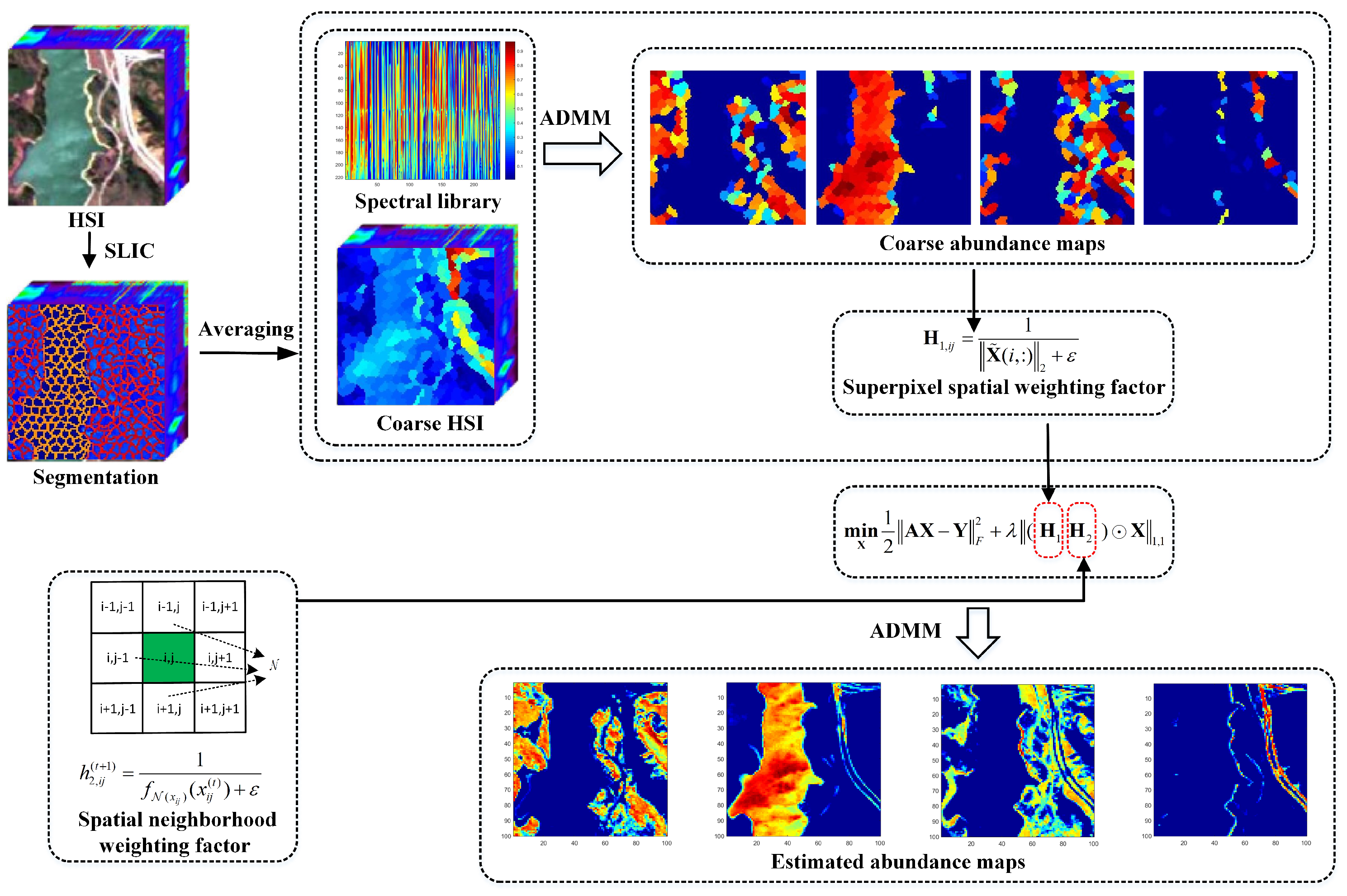
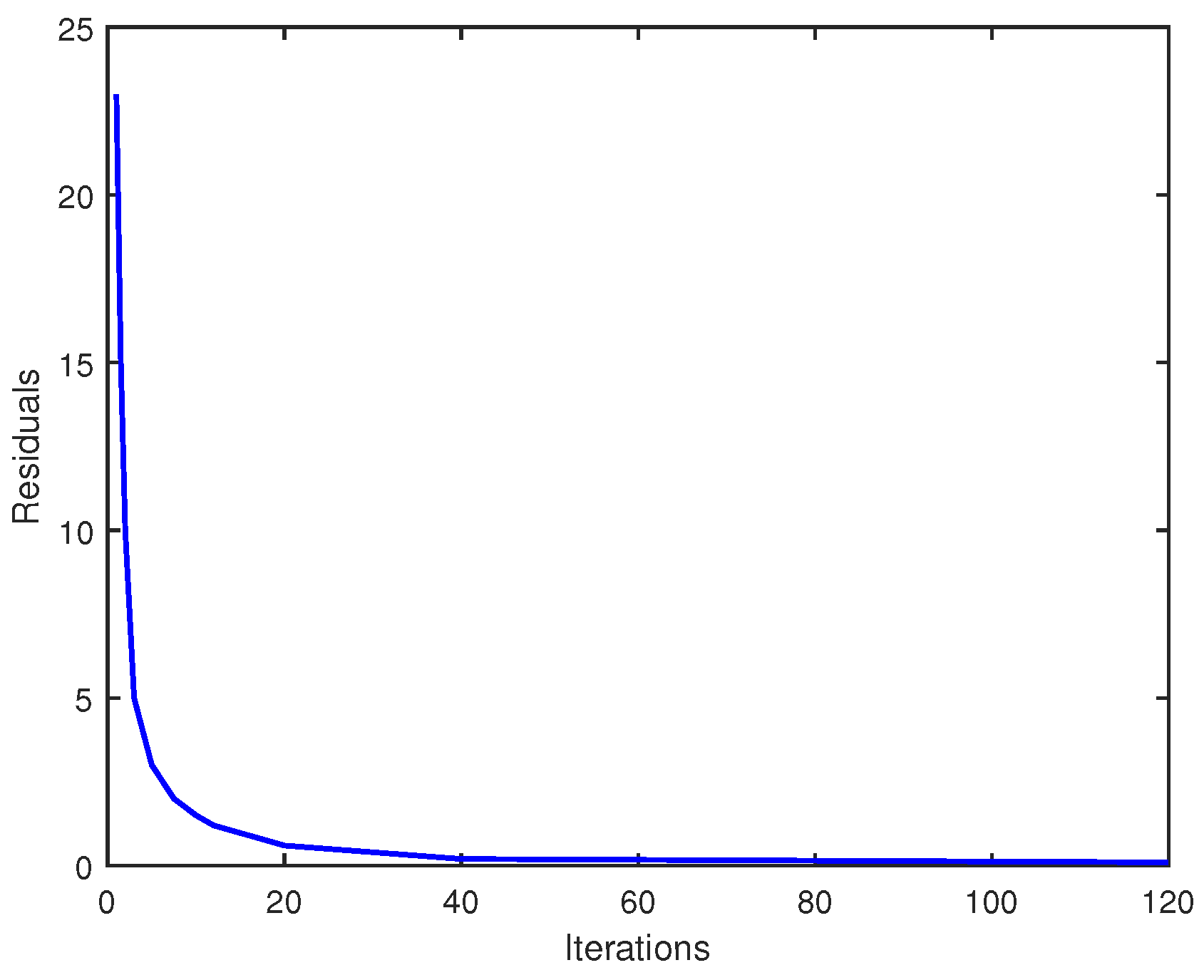
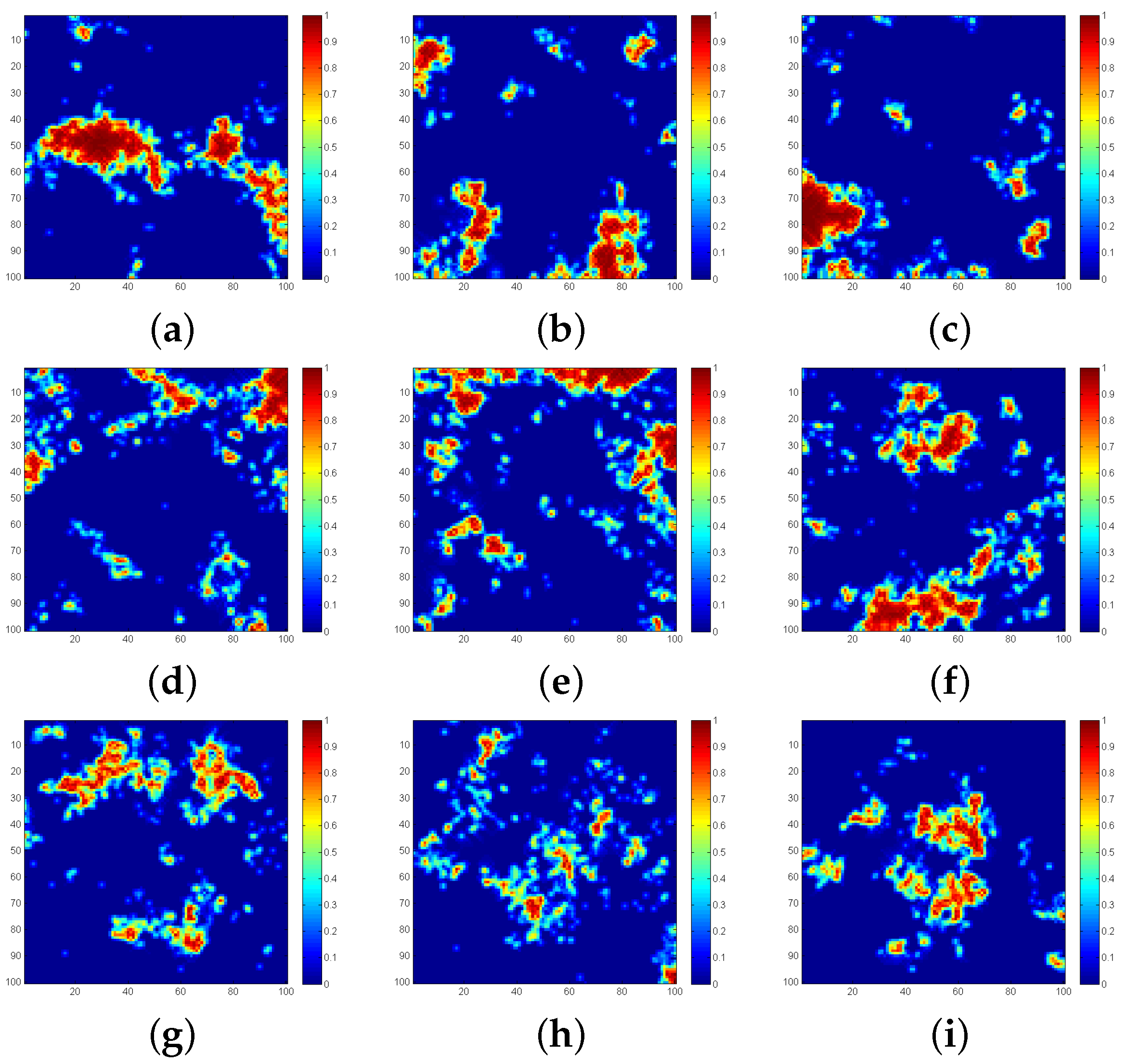

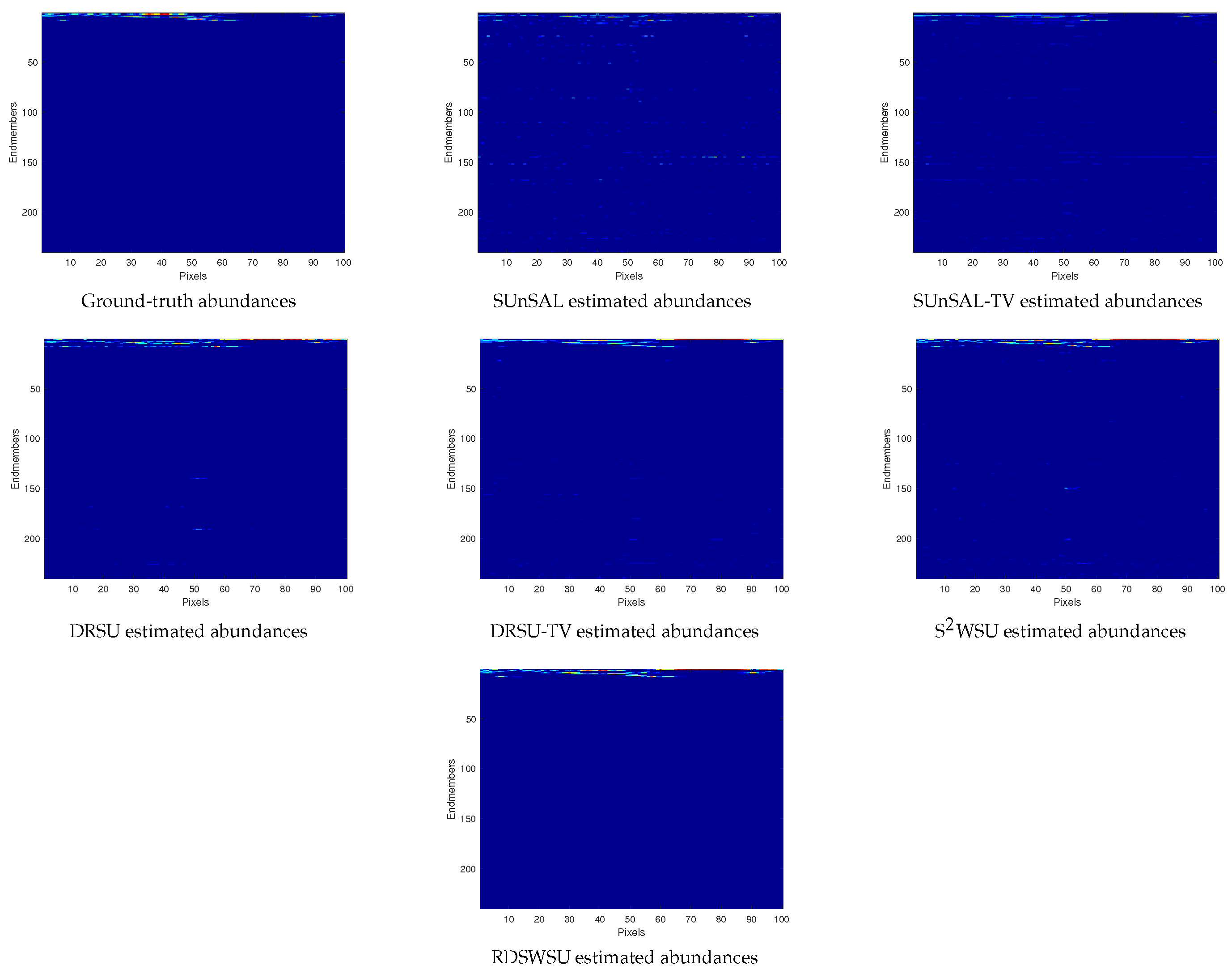
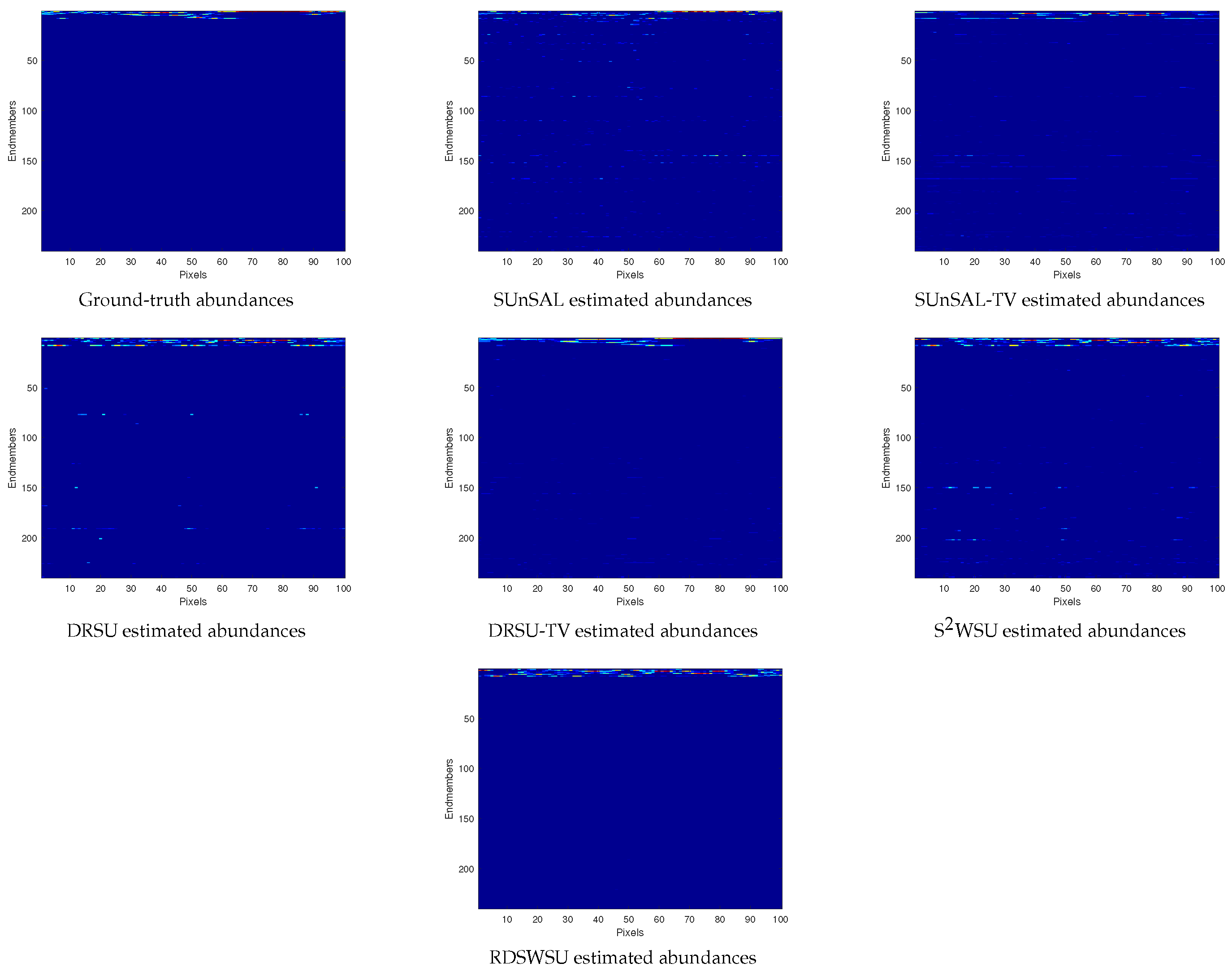


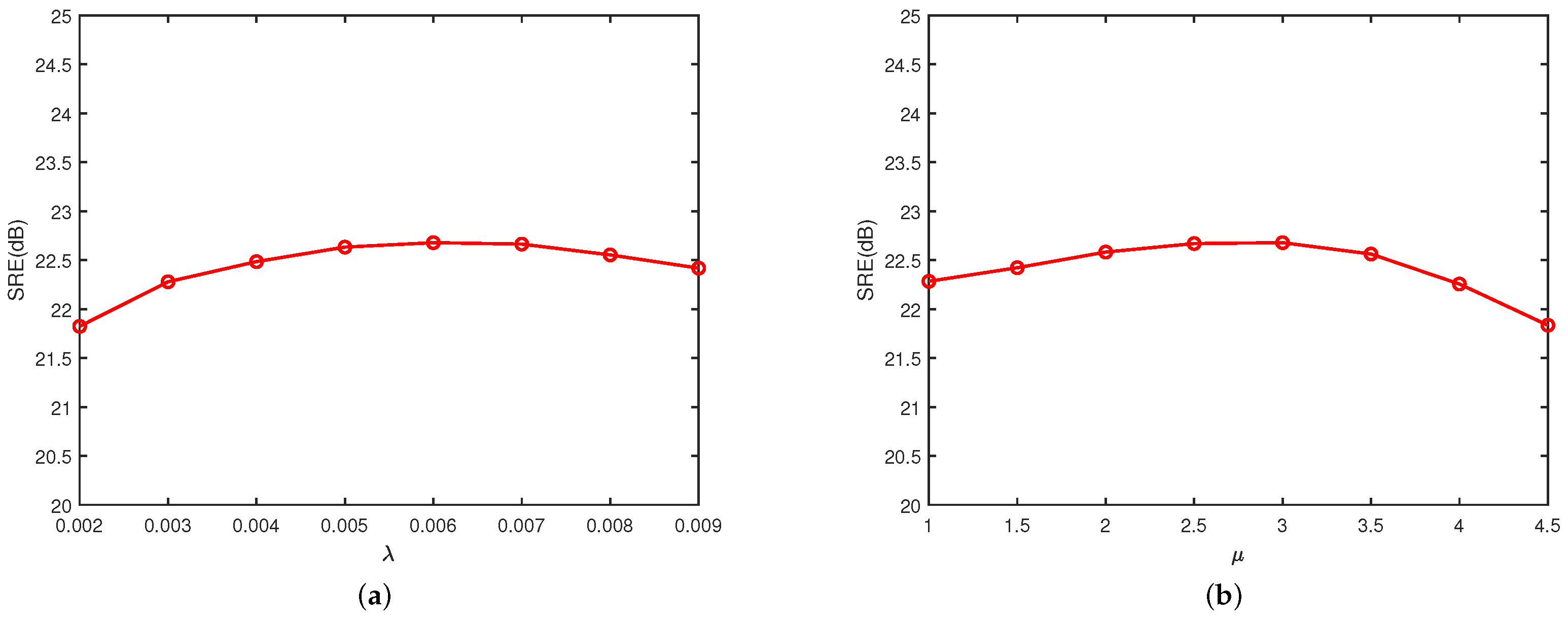
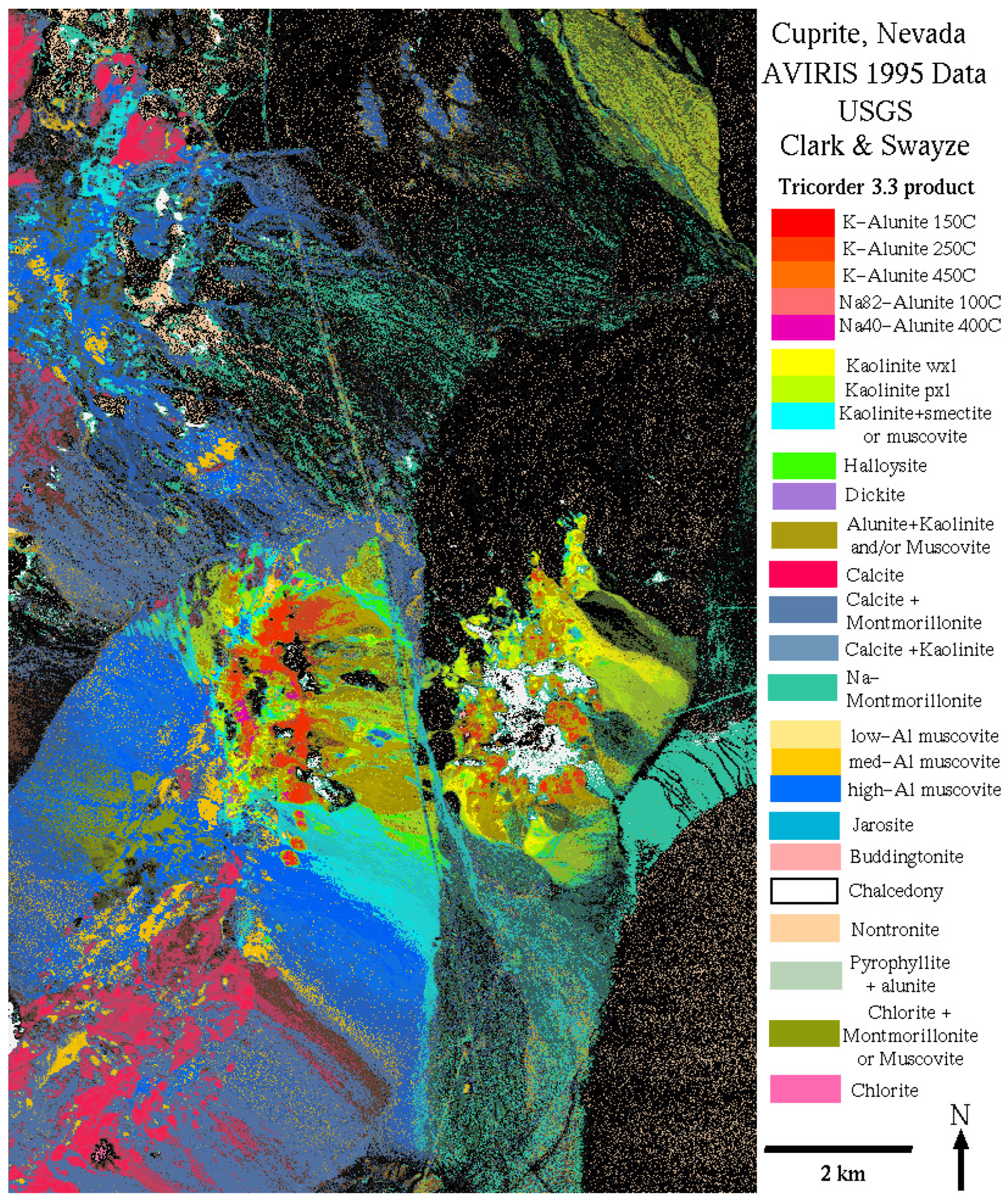
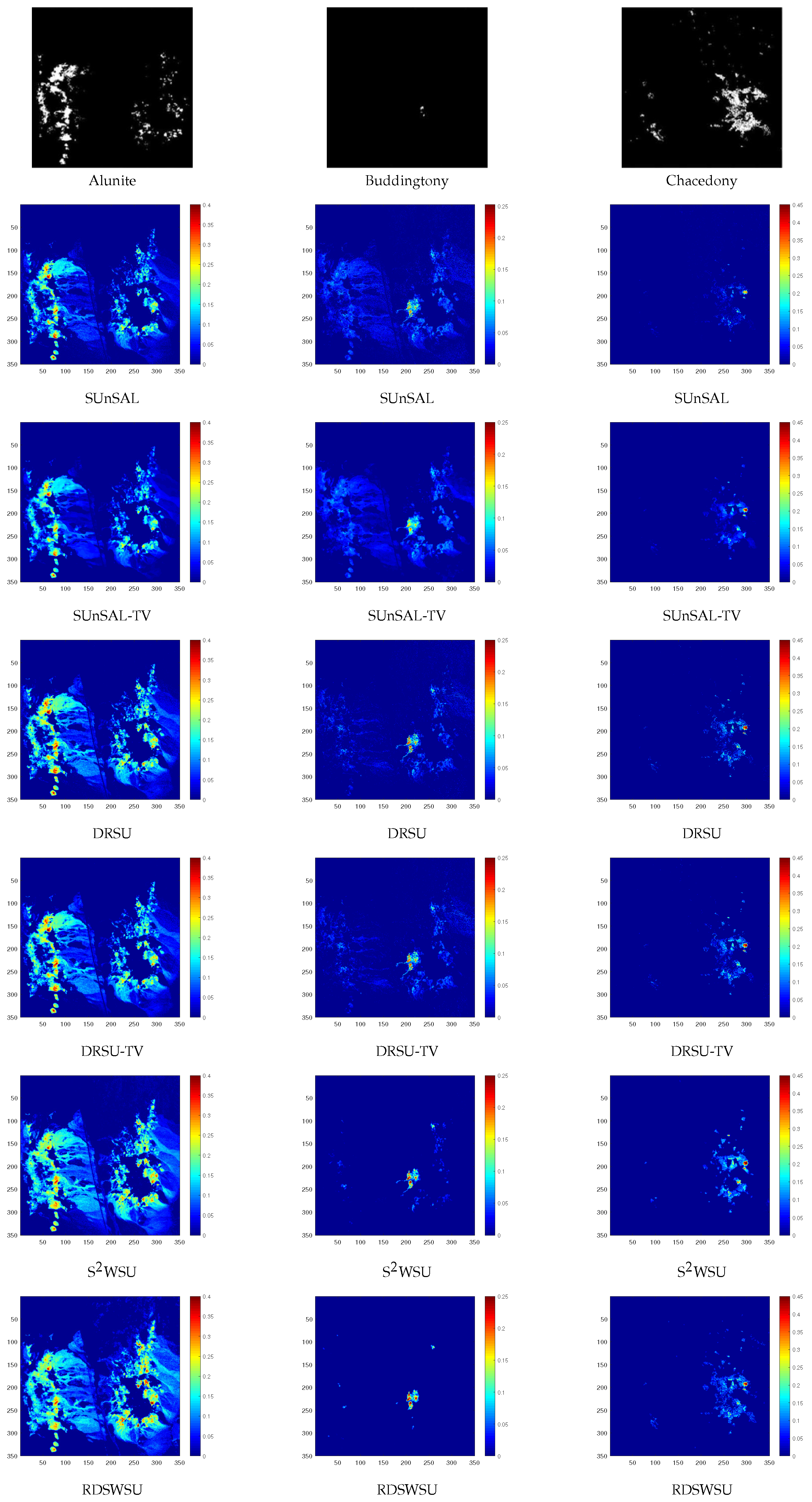
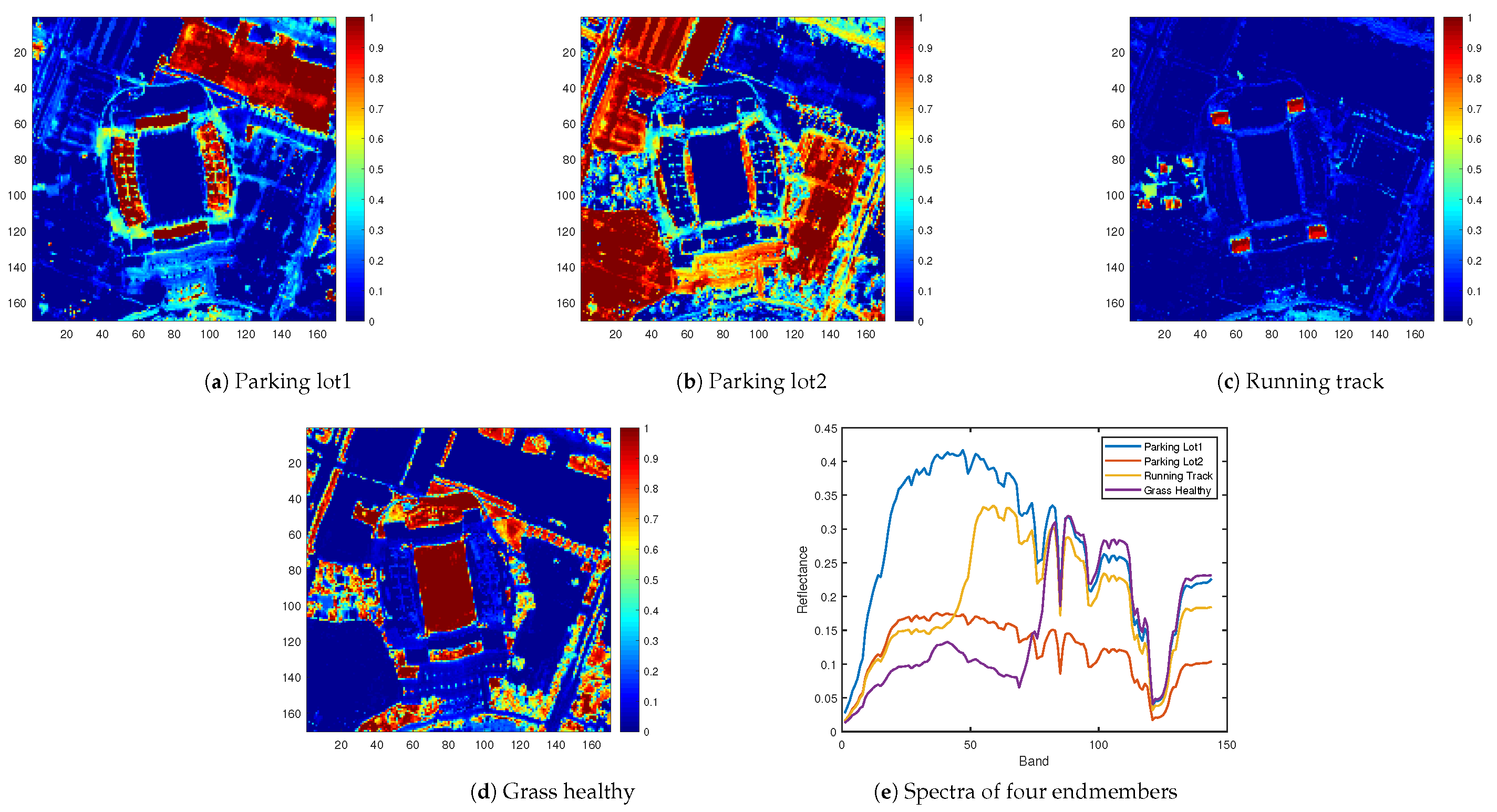
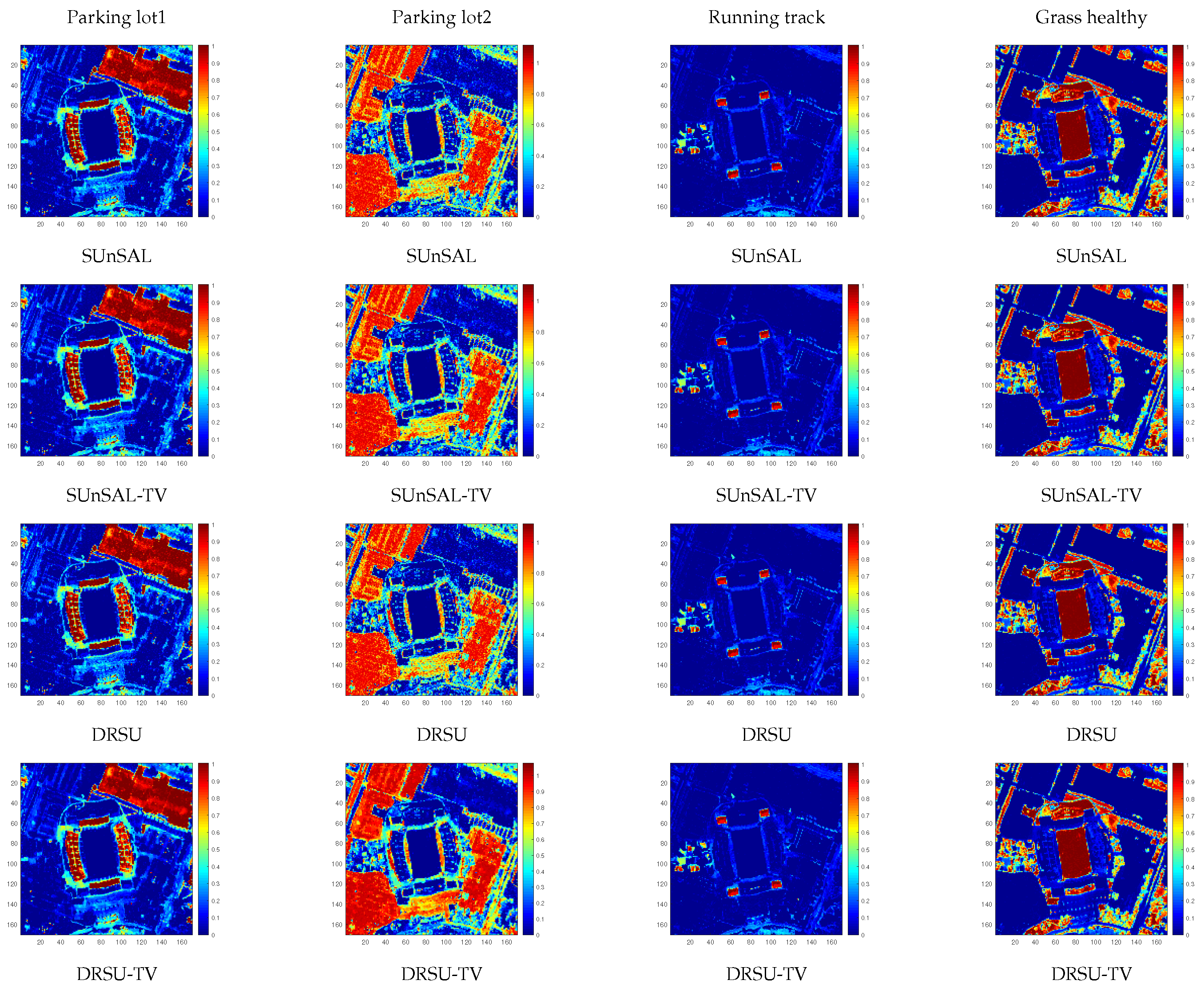
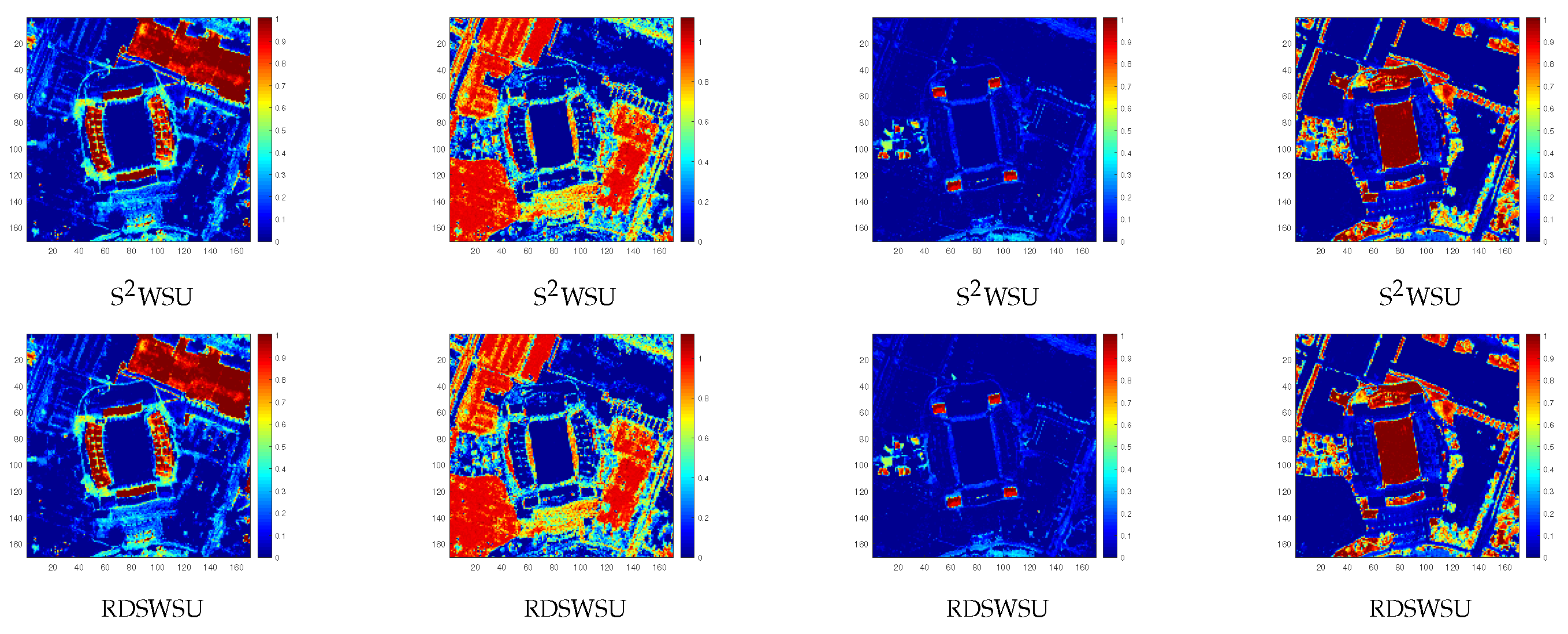
| Date Cube | SNR | SUnSAL | SUnSAL-TV | DRSU | DRSU-TV | SWSU | RDSWSU |
|---|---|---|---|---|---|---|---|
| 10 | 1.6582 | 3.9092 | 2.1998 | 4.3212 | 3.4088 | 5.6387 | |
| () | (; | () | (; | () | () | ||
| ) | ) | ||||||
| 20 | 4.1966 | 5.3175 | 4.5620 | 8.4389 | 7.8752 | 14.2101 | |
| () | (; | () | (; | () | () | ||
| ) | ) | ||||||
| DC1 | 30 | 8.5108 | 11.9497 | 15.2985 | 18.9425 | 21.8718 | 22.6783 |
| () | (; | () | (; | () | () | ||
| ) | ) | ||||||
| 40 | 15.2388 | 17.8119 | 29.5464 | 31.0163 | 32.1470 | 32.3118 | |
| () | (; | () | (; | () | () | ||
| ) | ) | ||||||
| 50 | 23.1066 | 26.0519 | 41.2077 | 40.8223 | 41.5089 | 41.9386 | |
| () | (; | () | (; | () | () | ||
| ) | ) | ||||||
| 10 | 0.6993 | 2.4822 | 0.9698 | 2.6009 | 1.9869 | 6.1135 | |
| () | (; | () | (; | () | () | ||
| ) | ) | ||||||
| 20 | 2.6569 | 4.9553 | 2.7730 | 7.6542 | 4.5408 | 11.9055 | |
| () | (; | () | (; | () | () | ||
| ) | ) | ||||||
| DC2 | 30 | 5.9799 | 9.5503 | 15.6040 | 18.8693 | 19.8190 | 20.1171 |
| () | (; | () | (; | () | () | ||
| ) | ) | ||||||
| 40 | 11.8340 | 15.2535 | 26.9881 | 28.2618 | 28.6033 | 28.6337 | |
| () | (; | () | (; | () | () | ||
| ) | ) | ||||||
| 50 | 18.7115 | 24.6150 | 35.3070 | 36.5517 | 36.7807 | 37.0450 | |
| () | (; | () | (; | () | () | ||
| ) | ) |
| Date Cube | SNR | SUnSAL | SUnSAL-TV | DRSU | DRSU-TV | SWSU | RDSWSU |
|---|---|---|---|---|---|---|---|
| 10 | 0.2933 | 0.5206 | 0.3777 | 0.5899 | 0.5058 | 0.6810 | |
| () | (; | () | (; | () | () | ||
| ) | ) | ||||||
| 20 | 0.5594 | 0.6406 | 0.6185 | 0.8387 | 0.8005 | 0.9716 | |
| () | (; | () | (; | () | () | ||
| ) | ) | ||||||
| DC1 | 30 | 0.7992 | 0.9492 | 0.9782 | 0.9994 | 1 | 1 |
| () | (; | () | (; | () | () | ||
| ) | ) | ||||||
| 40 | 0.9902 | 0.9996 | 1.0000 | 1.0000 | 1.0000 | 1 | |
| () | (; | () | (; | () | () | ||
| ) | ) | ||||||
| 50 | 1 | 1 | 1 | 1 | 1 | 1 | |
| () | (; | () | (; | () | () | ||
| ) | ) | ||||||
| 10 | 0.1812 | 0.3029 | 0.1903 | 0.4015 | 0.3451 | 0.6368 | |
| () | (; | () | (; | () | () | ||
| ) | ) | ||||||
| 20 | 0.3766 | 0.5031 | 0.4359 | 0.7186 | 0.6013 | 0.9076 | |
| () | (; | () | (; | () | () | ||
| ) | ) | ||||||
| DC2 | 30 | 0.5900 | 0.8023 | 0.9795 | 0.9976 | 1 | 1 |
| () | (; | () | (; | () | () | ||
| ) | ) | ||||||
| 40 | 0.9193 | 0.9884 | 1.0000 | 1.0000 | 1.0000 | 1 | |
| () | (; | () | (; | () | () | ||
| ) | ) | ||||||
| 50 | 0.9999 | 1 | 1 | 1 | 1 | 1 | |
| () | (; | () | (; | () | () | ||
| ) | ) |
| Algorithm | SUnSAL | SUnSAL-TV | DRSU | DRSU-TV | SWSU | RDSWSU |
|---|---|---|---|---|---|---|
| Time(s) | 23.29 | 231.13 | 72.45 | 250.00 | 79.53 | 80.84 |
Disclaimer/Publisher’s Note: The statements, opinions and data contained in all publications are solely those of the individual author(s) and contributor(s) and not of MDPI and/or the editor(s). MDPI and/or the editor(s) disclaim responsibility for any injury to people or property resulting from any ideas, methods, instructions or products referred to in the content. |
© 2023 by the authors. Licensee MDPI, Basel, Switzerland. This article is an open access article distributed under the terms and conditions of the Creative Commons Attribution (CC BY) license (https://creativecommons.org/licenses/by/4.0/).
Share and Cite
Deng, C.; Chen, Y.; Zhang, S.; Li, F.; Lai, P.; Su, D.; Hu, M.; Wang, S. Robust Dual Spatial Weighted Sparse Unmixing for Remotely Sensed Hyperspectral Imagery. Remote Sens. 2023, 15, 4056. https://doi.org/10.3390/rs15164056
Deng C, Chen Y, Zhang S, Li F, Lai P, Su D, Hu M, Wang S. Robust Dual Spatial Weighted Sparse Unmixing for Remotely Sensed Hyperspectral Imagery. Remote Sensing. 2023; 15(16):4056. https://doi.org/10.3390/rs15164056
Chicago/Turabian StyleDeng, Chengzhi, Yonggang Chen, Shaoquan Zhang, Fan Li, Pengfei Lai, Dingli Su, Min Hu, and Shengqian Wang. 2023. "Robust Dual Spatial Weighted Sparse Unmixing for Remotely Sensed Hyperspectral Imagery" Remote Sensing 15, no. 16: 4056. https://doi.org/10.3390/rs15164056
APA StyleDeng, C., Chen, Y., Zhang, S., Li, F., Lai, P., Su, D., Hu, M., & Wang, S. (2023). Robust Dual Spatial Weighted Sparse Unmixing for Remotely Sensed Hyperspectral Imagery. Remote Sensing, 15(16), 4056. https://doi.org/10.3390/rs15164056






